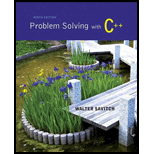
Concept explainers
Linked list:
- Linked list denotes a linear data structure.
- The elements are not stored at contiguous locations; the elements are linked using pointers.
- It stores linear data of similar types not like arrays.
- The size of linked list can be changed based on requirement.
- It is represented by a pointer to first linked list node.
- The first node denotes a head.
- If linked list is empty, value of head is NULL.
- The node in a list has two parts, data and pointer to next node.
Given code:
//Define a structure
struct Box
{
//Declare variable
string name;
//Declare variable
int number;
//Define pointer to next
Box *next;
};
//Create an instance
BoxPtr head;
//Assign value
head = new Box;
//Assign value
head->name = "Sally";
//Assign value
head->number = 18;
//Assign value
head->next = NULL;
//Display value
cout << (*head).name << endl;
//Display value
cout << head->name << endl;
//Display value
cout << (*head).number << endl;
//Display value
cout << head->number << endl;
Explanation:
- The “Box” defines a structure with “name” and “number” as members.
- It contains a pointer to next element of list.
- The “BoxPtr head” creates an instance of structure.
- A new “Box” element is created.
- The values of “name” and “number” are been set.
- The values of “name” and “number” are been displayed.
- The member variable next to the node is been set to NULL.
Complete program:
//Include libraries
#include<iostream>
#include<string>
//Use namespace
using namespace std;
//Define a structure
struct Box
{
//Declare variable
string name;
//Declare variable
int number;
//Define pointer to next
Box *next;
};
//Define instance
typedef Box* BoxPtr;
//Define main method
void main()
{
//Create an instance
BoxPtr head;
//Assign value
head = new Box;
//Assign value
head->name = "Sally";
//Assign value
head->number = 18;
//Display value
cout << (*head).name << endl;
//Display value
cout << head->name << endl;
//Display value
cout << (*head).number << endl;
//Display value
cout << head->number << endl;
//Delete
delete head;
//Display message
cout<<"List head is been destroyed"<<endl;
//Pause console window
system("pause");
}
Explanation:
- The “Box” defines a structure with “name” and “number” as members.
- It contains a pointer to next element of list.
- Define a main method
- The “BoxPtr head” creates an instance of structure.
- A new “Box” element is created.
- The values of “name” and “number” are been set.
- The values of “name” and “number” are been displayed.
- The member variable next to the node is been set to NULL.
- The linked list is been destroyed using “delete” statement.
Want to see the full answer?
Check out a sample textbook solution
Chapter 13 Solutions
Problem Solving with C++ (9th Edition)
- Programming Logic & Design ComprehensiveComputer ScienceISBN:9781337669405Author:FARRELLPublisher:Cengage
 C++ for Engineers and ScientistsComputer ScienceISBN:9781133187844Author:Bronson, Gary J.Publisher:Course Technology Ptr
C++ for Engineers and ScientistsComputer ScienceISBN:9781133187844Author:Bronson, Gary J.Publisher:Course Technology Ptr Microsoft Visual C#Computer ScienceISBN:9781337102100Author:Joyce, Farrell.Publisher:Cengage Learning,
Microsoft Visual C#Computer ScienceISBN:9781337102100Author:Joyce, Farrell.Publisher:Cengage Learning,  C++ Programming: From Problem Analysis to Program...Computer ScienceISBN:9781337102087Author:D. S. MalikPublisher:Cengage Learning
C++ Programming: From Problem Analysis to Program...Computer ScienceISBN:9781337102087Author:D. S. MalikPublisher:Cengage Learning EBK JAVA PROGRAMMINGComputer ScienceISBN:9781337671385Author:FARRELLPublisher:CENGAGE LEARNING - CONSIGNMENT
EBK JAVA PROGRAMMINGComputer ScienceISBN:9781337671385Author:FARRELLPublisher:CENGAGE LEARNING - CONSIGNMENT Systems ArchitectureComputer ScienceISBN:9781305080195Author:Stephen D. BurdPublisher:Cengage Learning
Systems ArchitectureComputer ScienceISBN:9781305080195Author:Stephen D. BurdPublisher:Cengage Learning





